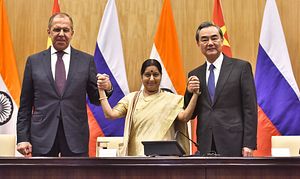This week, the foreign ministers of Russia, India, and China met for their fifteenth ministerial trilateral meeting in New Delhi. Russia was represented by Foreign Minister Sergei Lavrov, India by External Affairs Minister Sushma Swaraj, and China by Foreign Minister Wang Yi. In a lengthy joint statement released after the meeting, the three sides stated their interest, concern, and objectives on a range of issues.
The meeting is the first ministerial meeting of its kind since India’s lengthy summer standoff with China along their disputed Himalayan border, in Doklam. It also comes after the recent working-level meeting of the so-called ‘Quad’ of countries on the sidelines of the Association of Southeast Asian Nations (ASEAN) summits in Manila in November. India, along with Japan, the United States, and Australia, participated in that meeting, which was perceived as a coming-together of likeminded Asia-Pacific democracies to balance China. (Indeed, Chinese Foreign Minister Wang warned India of “cliques,” a less-than-subtle reference to the reconvened ‘Quad’.)
The Russia-India-China trilateral format yields varied results from year to year and while the joint communiques released after their meetings are always long and comprehensive, they do vary considerably from year to year. Last year, for example, I’d observed that India had signed on to a joint statement with Russia and China that outlined a conspicuously China-oriented view of the South China Sea disputes.
This year, that paragraph didn’t appear, which is unsurprising given India’s recent full-throated support for the concept of a “free and open Indo-Pacific,” which privileges freedom of navigation and international law in Asia’s maritime commons. This year’s Russia-India-China joint communique did nevertheless mention freedom of navigation, but made no reference to the South China Sea specifically: “Recognising the growing importance of maritime-trade in an increasingly globalised world, we support freedom of navigation and overflight rights based on the principles of international law, particularly UNCLOS.” (Last year’s statement was likely the result of China’s diplomatic push for support before the hotly anticipated ruling of the Hague-based arbitral tribunal in the case filed against Beijing by Manila in 2013.)
The rest of this year’s statement is comprehensive and mostly unremarkable. It references a range of issues that each of the three countries care about, including climate change, terrorism (without explicitly naming Pakistan-based groups), regional connectivity, tensions on the Korean Peninsula, in eastern Ukraine, and Afghanistan. Like the outcome of any grouping comprising India and China, these statements are necessarily limited in their scope. The Russia-India-China trilateral format nevertheless continues to be a priority for these three countries, despite their common participation in the BRICS grouping and the Shanghai Cooperation Organization, where India recently became a member. This year’s meeting, however, doesn’t augur positively for the relevance of this trilateral, which may continue to wane as India finds itself increasingly drawn toward Asia’s like-minded democracies.

































